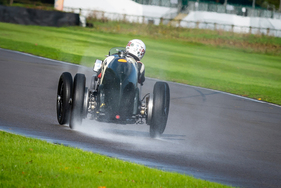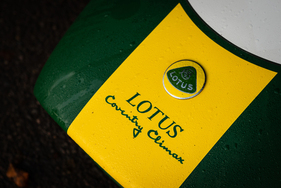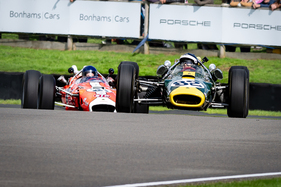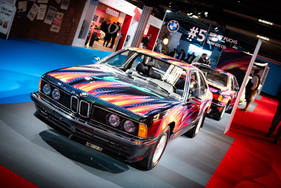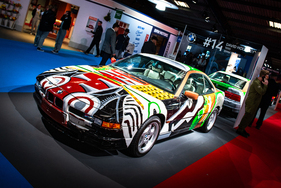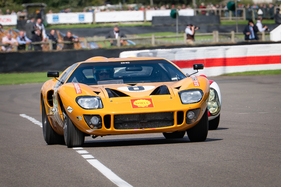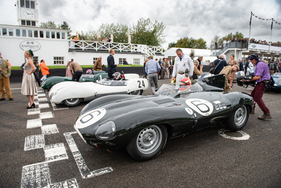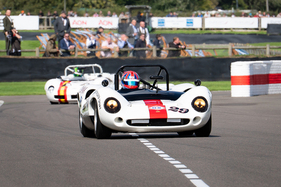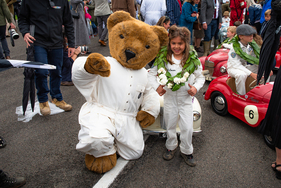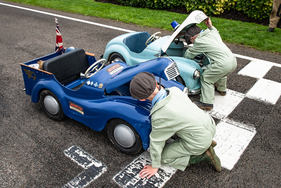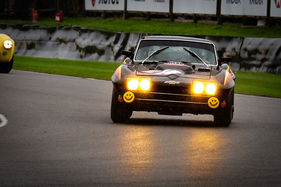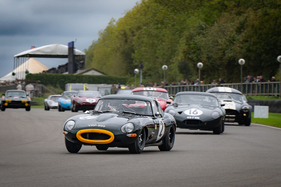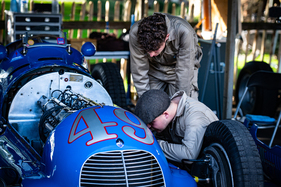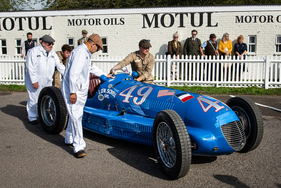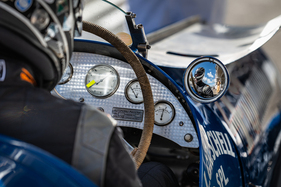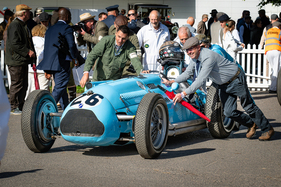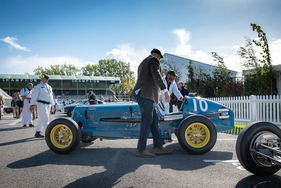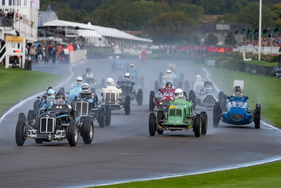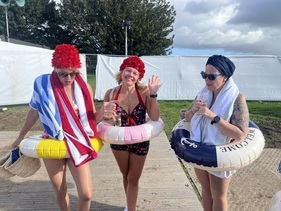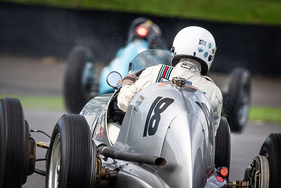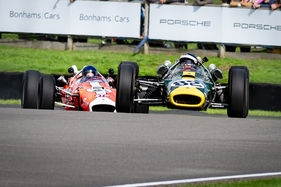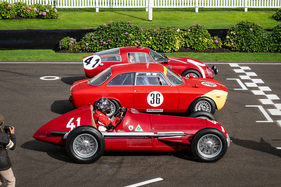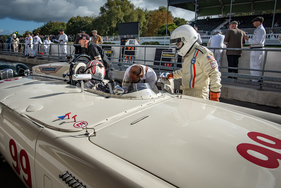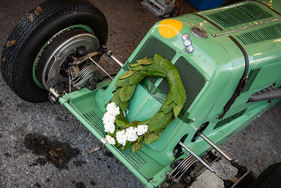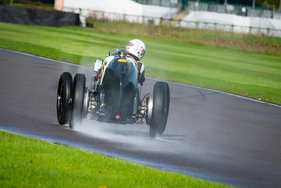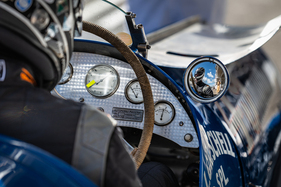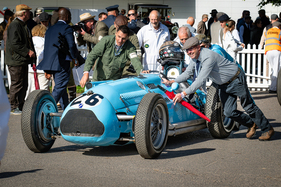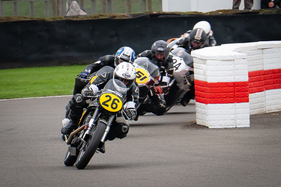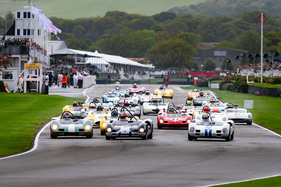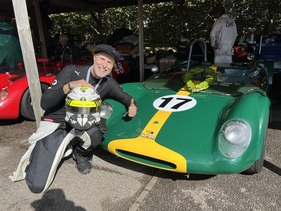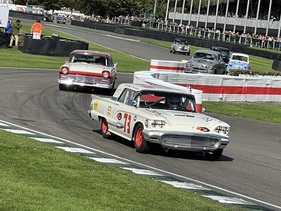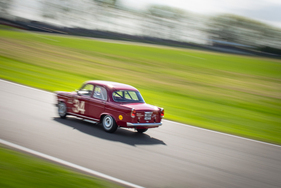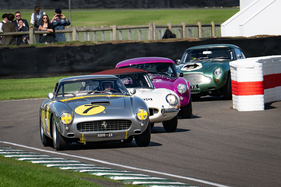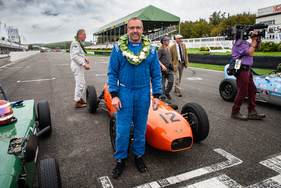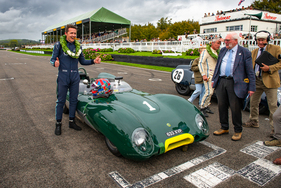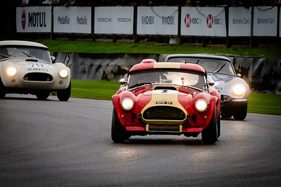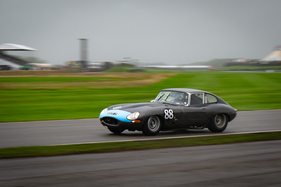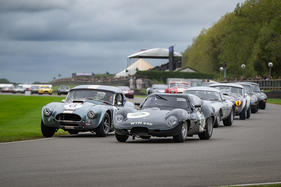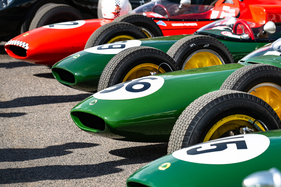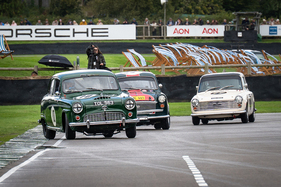The cheerful bathing beauties that crossed my path as soon as I entered the Goodwood Revival 2025 on the first of the three days of the event somehow didn't match the gloomy weather. However, they, or rather all the visitors, put a good face on the "nasty" game that Peter was playing, just like last year. After it had already rained on the previous days and access paths had turned into muddy trails, sun and rain alternated on Friday.
At least it stayed dry from Saturday afternoon with lots of sunshine at times until the dark Sunday afternoon, and it wasn't really cold despite the moderate wind. This didn't stop English women in particular from wearing summery attire - after all, the revival also wants to be experienced and understood as a lively nostalgic open-air theater.
However, the rainy Saturday morning or the forecast for Sunday may have deterred some spectators from attending the sold-out event. Although official sources report around 150,000 people over all three days, it has rarely been so easy to get through in recent years. The only crowds were at the critical points in the infield of the legendary Goodwood Circuit and in the paddock area.
Homage to Alfa Romeo, Jim Clark and the VW Bulli
This year's three track parades were dedicated to Alfa Romeo, Jim Clark and the Volkswagen Type 2, with racing models from the Italian brand from 1925 to 1975 and those from the career of the 1963 and 1965 world champion, who died in an accident in 1968, completing their demonstration laps at a moderate pace.
However, the VW Bullis were only seen on the circuit by those who were present at 9 a.m. every day before these iconic vehicles were on display in various designs throughout the area.
One gag was the flock of sheep driven through the starting grid of various Lotus and other vehicles as part of the tribute to Jim Clark held by host Duke of Richmond - the unforgettable Scot was the son of a sheep farmer and grew up surrounded by these animals.
It is rare to see so many pre-war racing sports cars, as well as some TZ1, TZ2 and GTAs, from Alfa Romeo in action in one place.
Unfortunately, the showpiece, the Tipo 158 "Alfetta", could only be seen on Friday at the parade and on Saturday morning in the race of the pre-war GP racing cars. If you were in the Alfa Romeo pits at the right time, you could at least hear and smell the brute sound of the 1.5-liter inline eight-cylinder engine with Roots supercharger during the daily warm-up.
British favorite as opening winner
The race kicked off on Friday evening with the Freddie March Memorial Trophy, featuring cars in the spirit of the legendary Goodwood Nine Hours from 1952 to 1955.
The Ford Thunderbird "Battlebird", a roadster version of the American thunderbird, won the start on a still dry track from row 2, before pole setter Jenson Button in a Jaguar C-type prevailed from the third lap.
The lead only changed hands at the driver swap, before Alex Buncombe, partnering the popular 2009 Formula 1 world champion, brought the sports car home after an hour, now in the rain, with a lead of more than a minute over the HWM Jaguar of Hancock/Hunt and the Austin-Healey 100S of Hill/Rawles - all the others, including the fifth-placed driver, were in the lead. all the others, including the fifth-placed Thunderbird of Romain Dumas and Bill Shepherd, were lapped. The best of the German-speaking drivers was Wolfgang Friedrichs together with Simon Hadfield in tenth place in his Aston-Martin DB3S. Marcel Fässler and Hans-Martin Schneeberger brought their Jaguar C-type home in 16th position, three laps down.
Difficult conditions for the oldest cars
The GP racing cars and Voiturettes from 1930 to 1951 opened the first day of racing on Saturday morning on a rain-soaked track, which put the brakes on many a driver's valuable and difficult-to-tame machine. No wonder that the British once again clearly set the pace.
Mark Gillies coped best with the difficult conditions at the wheel of a 1934 ERA A-type 3RA. With skillful drifting, the Briton drove to his eighth triumph in the past two decades. "A fantastic car that you can simply do anything with," enthused the Briton.
Patrick Blakeney-Edwards on a Frazer-Nash was only just two seconds behind at the end.
Andy Willis drove the beefy blue Maserati 8CTF, which he had only been able to try out briefly at the Goodwood Festival of Speed before qualifying (9th), virtually straight from the museum to the podium.
Volker Hichert finished a good tenth, 57 seconds behind, in his Talbot-Lago T26C and the aforementioned "Alfetta", with Peter Greenfield at the wheel, crossed the finish line in twelfth place after 20 minutes of racing.
On the podium with two wheels instead of four
The daring two-wheeled pilots gave a taste of their skills in their first 25-minute run on a still very wet track. Emanuele Pirro, who had made a name for himself as an F1 driver (3 world championship points), in the DTM and above all as a five-time winner of the 24 Hours of Le Mans with Audi, deserved special praise. Partnering TT warhorse Michael Russell, the Italian earned the coveted Goodwood laurel wreath and cigar in third place in the first race. On Sunday, they brought the Norton-Manx home in fourth place and thus went down in the annals of the Revival as third overall in the addition of the two races
Laurel wreath for a German newcomer
The 25 drivers in the Madgwick Cup started their race in their small 1960s sports cars with a displacement of up to two liters on a drying track before it started to rain again. After several spins in the field and the accident of race leader Olly Birkett in an Elva BMW on lap 6, race control interrupted the action with a red flag. Although there was no more rain at the restart, the thoroughly entertaining action was stopped after a further three laps.
While William Nuthall was able to win just ahead of Max Bartell, Wolfgang Henseler crossed the finish line in a surprising third place, having been eighth at the first stop. Henseler had only bought the Lotus-Ford 23C from Briton Charlie Best three weeks earlier and therefore slipped into the field so late that the timing system still listed him as Charlie Best in qualifying and on the grid! "I had only watched this track on YouTube beforehand. To finish on the podium from 15th on the grid was completely unexpected," said the 64-year-old historic racer from Offenbach near Frankfurt, who was delighted with one of his greatest successes to date.
V8 power dominates the first touring car race
The St Mary's Trophy Race Part 1 is usually similarly turbulent when the professionals at the wheel of the touring cars - this year from the 1950s - go at it. However, with the exception of minor skirmishes without consequences, there was no major carnage.
With the weather finally looking nice, BTCC star Gordon Shedden in his Jaguar Mk1 was not able to stay ahead of Andrew Jordan's Austin A40 for long before Steve Soper, who had started alongside them from row 1 in the Ford Fairlane, took command. Tom Kristensen in the mighty Ford Thunderbird soon appeared in Soper's rear-view mirror, whereupon the two fought a great duel in the V8 cars.
In the end, Soper was no longer able to keep the Dane at bay, whereupon Kristensen secured the first Goodwood victory in 2025 for a non-British driver - not his first at the Revival, of course. Three British Austin A40s and Jenson Button's Alfa Romeo Giulietta TI finished in sixth place behind the two American big ships.
In seventh place, Swiss Le Mans triple winner Marcel Fässler pulled off a brilliant performance in another Austin. As he said himself before the race, he clearly enjoyed this little car.
A Porsche 904 in front of four Lotus Elan
The Fordwater Trophy for production sports cars and GTs from 1964 to 1966 was dominated by the Porsche 904 GTS and Lotus Elan. Andrew Smith gave the German brand victory in the briefly interrupted race ahead of four British Lotus Elan 26Rs, led by the fastest Shapecraft model. All-rounder Emanuele Pirro brought the 904 Carrera GTS entrusted to him home in sixth place ahead of fellow brand driver Carlos de Quesada and Michael Gans' Abarth-Simca 2000.
Fast Porsche 910 among the V8 cars
In Friday's qualifying session for the Whitsun Trophy for high-displacement sports prototypes up to 1966, Nick Padmore in the Lola T70 Spyder set the fastest lap of the weekend with a time of 1:19.718 and an average speed of almost 173 km/h. However, Miles Griffith returned first. However, Miles Griffith in a McLaren-Chevy M1A was the first to return from the starting lap, after which Alex Brundle in the Lola-Chevy T70 Spyder set the pace for seven laps before Padmore took the lead. When Padmore retired with a defect three laps before the end, Brundle took over the lead again until the finish after 26 loud minutes. Eight seconds behind, Griffith narrowly took second place ahead of Oliver Bryant in another Lola.
Toni Seiler, who started 19th on the grid, finished the race in twelfth place, which was a small consolation for him and his helpers from Switzerland after a training accident with the Lola borrowed from Belgian Marc Devis and repaired on site. Phil Keen sensationally drove a Porsche 910 to fourth place ahead of many other V8 cars.
There is also Ferrari
The Stirling Moss Memorial Trophy for closed GT cars up to 1963 ended the first day of racing in conditions that remained good. The Ferrari brand was finally able to make its presence felt in a race with a strong driver line-up, with Dutch drivers Yelmer Buurman/Alexander van der Lof bringing the fastest of four 250 GT SWBs home in third place. After 37 minutes, the clear victory went to Brits Andrew Jordan/Matthew Holme ahead of ex-Indycar star Dario Franchitti and Gregor Fisken, both in Cobra 260.
Mitter-DKW provides acoustic variety
The first three races on Sunday took place under a thick blanket of cloud that threatened rain for the day's racing. The Chichester Trophy for Formula Junior racing cars with front engines was an almost purely British affair, which ended with a start/finish victory for Stuart Roach in an Alexis-Ford ahead of driver/designer Ray Mallock in the peculiar U2-Ford, Adrian Russell in a Condor-Ford and Joe Colasacco with the Ferrari-look OSCA-Fiat. A splash of color was provided by Rudolf Ernst in the Mitter-DKW M2 in 19th place out of 30 competitors.
The first was not the winner in the end
Spectators were treated to a sensational battle between the fastest drivers in the Sussex Trophy for sports cars from 1955 to 1960. When the Scarab Chevrolet of Christian Albrecht, who was among the leading group, left a trail of oil behind him, several of his pursuers stumbled, causing the race to be interrupted. The race was restarted after the recovery of the damaged vehicles and the cleaning of the track. After seven laps, Oliver Bryant's Lotus-Climax 15, which had already been fastest in qualifying, saw the checkered flag first, but then fell through technical inspection. Chris Ward in the Jaguar D-type inherited the victory ahead of James Wood in the Lotus-Climax 15 and James Cottingham in the Tojero-Jaguar, three equally well-known names in Historic Racing.
The expected rain as a spoilsport
The Sunday Alfa parade, the second motorcycle race and the commemoration of the end of the Second World War 80 years ago remained dry, as did the starting phase of the RAC TT Celebration, the race for GT cars up to 1964.
When Afshin Fatemi hit the embankment with his Tojero-Ford EE Coupé, the race had to be interrupted. Unfortunately, the expected and persistent rain set in during this forced break, which ultimately affected the classification. The Jaguar E-type now had an advantage over the Shelby Cobras with their strong rear axle, which were impaired in the wet, or the fast TVR Griffith with its short wheelbase.
Shortly before the end, former touring car world champion Rob Huff in the E-type FHC snatched the lead, but a pit stop that was a little too short dropped him and Andrew Bentley back to second place behind Tom Ingram and Richard Kent in the semi-lightweight model after a time penalty. Andy Priaulx and Frederic Wakeman finished third in the Lister-Jaguar Costin to ensure the brand's total triumph. The following four Cobra teams all lost one to two minutes. Lukas Halusa and André Lotterer had to settle for eleventh place despite their initially fast lap times in their Jaguar.
After taking over from Scott Malvern, Marcel Fässler was unable to do much with a Corvette (16th), and with the underpowered Porsche 906 and a very slow Japanese partner in the dry, Neel Jani was the second Swiss driver in the field to lose out despite fast lap times in the rain.
An Austrian outdoes the British - but only in practice
The drivers in the Formula 1 cars up to 1966, in which Jackie Stewart and Jim Clark once jointly set the Goodwood lap record in 1:20.4, were then barely able to develop properly. In the rain, the fastest drivers were around 30 seconds slower than in practice. With an average speed of 111 km/h, Stuart Hall in the Lotus 21 took the victory ahead of Ben Mitchell in a Cooper T56 and Kyle Tilly in the rare Gilby Type B, all with Climax engines. Austrian Lukas Halusa set the fastest time in practice in a Brabham BT7, but had to let the three fastest Brits push him back to fourth place in the wet. Joe Colasacco, second in practice in the Ferrari 1512 - a sonorous 1.5-liter twelve-cylinder - was even pushed down to ninth place. In view of the conditions and a BRM engine that did not run cleanly in practice (10th), Swiss driver Philipp Buhofer decided not to start. As a result, the entrepreneur from Cham safely made the scheduled flight back home on Sunday evening.
Rudi Friedrich's brilliant third place
In the Richmond & Gordon Trophy for GP racing cars from 1954 to 1960 with 2.5-liter engines, Andy Willis in the BRM P48 and Will Nuthall in the Cooper-Climax T52 drove clear of their opponents after two laps behind the safety car. Rudi Friedrichs, who started from the middle of row 1 in his Cooper, was unfazed by the difficult conditions and finished a magnificent third, breaking the phalanx of the rain-accustomed Brits.
Triple Jaguar victory in the touring cars
Finally, Part 2 of the St Mary's Trophy, in which mainly the owners of the touring cars were at the start, formed the wet conclusion of the Goodwood Revival 2025 in front of significantly thinned rows of spectators and grandstand seats.
With James Dorlin, Chris Ward and Grant Williams, there was another triple Jaguar victory ahead of the 1959 Austin Mini of fast tuner Nick Swift. Shedden/Ward in the Jaguar Mk1 took the overall touring car victory ahead of Brundle/Dorlin in the Lister Jaguar Mk1 and Soper/Thistlethwayte (please pronounce that!) in Sunday's chanceless Ford Fairlane.
The previous day's winners Kristensen and Shepherd finished a thankless fourth. The best German-speaking driver was Neel Jani with partner Williams in the Jaguar Mk1 in seventh place and Marcel Fässler in the Austin A40 with Matt Manderson in ninth.
Even later next year
If you want to watch the Goodwood Revival 2026 live, you can already plan your trip. It will not take place until September 18-20 next year. The later date is the only GP-free weekend in September and does not mean anything in terms of the weather. What's more, after two rather wet events, it can only get better...
All results in detail can be found HERE

























